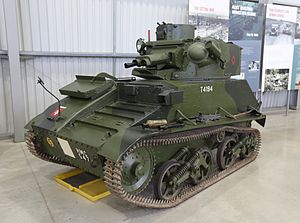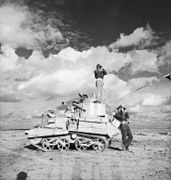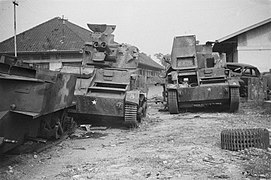
The Infantry Tank Mark II, best known as the Matilda, is a British infantry tank of the Second World War.

The M3 Lee, officially Medium Tank, M3, was an American medium tank used during World War II. The turret was produced in two forms, one for US needs and one modified to British requirements to place the radio next to the commander. In British Commonwealth service, the tank was called by two names: tanks employing US pattern turrets were called "Lee", named after Confederate general Robert E. Lee, while those with British pattern turrets were known as "Grant", named after Union general Ulysses S. Grant.

The Vickers 6-ton tank or Vickers Mark E, also known as the "Six-tonner" was a British light tank designed as a private project at Vickers. It was not adopted by the British Army, but was picked up by many foreign armed forces. It was licensed by the Soviet Union as the T-26. It was also the direct predecessor of the Polish 7TP tank.

The Tank, Infantry, Mk III, Valentine was an infantry tank produced in the United Kingdom during World War II. More than 8,000 of the type were produced in eleven marks, plus various specialised variants, accounting for approximately a quarter of wartime British tank production. The many variants included riveted and welded construction, petrol and diesel engines and a progressive increase in armament. It was supplied in large numbers to the USSR and built under licence in Canada. It was used extensively by the British in the North African campaign. Developed by Vickers, it proved to be both strong and reliable.

The Cromwell tank, officially Tank, Cruiser, Mk VIII, Cromwell (A27M), was one of the series of cruiser tanks fielded by Britain in the Second World War. Named after the English Civil War-era military leader Oliver Cromwell, the Cromwell was the first tank put into service by the British to combine high speed from a powerful, reliable engine and reasonable armour. The intended dual-purpose high velocity gun could not be fitted in the turret, so a medium velocity dual purpose gun was fitted instead. Further development of the Cromwell combined with a high velocity gun led to the Comet tank.

Crusader, in full "Tank, Cruiser Mk VI, Crusader", also known by its General Staff number A.15, was one of the primary British cruiser tanks during the early part of the Second World War. Over 5,000 tanks were manufactured and they made important contributions to the British victories during the North African campaign. The Crusader tank would not see active service beyond Africa but the chassis of the tank was modified to create anti-aircraft, fire support, observation, communication, bulldozer and recovery vehicle variants.

The Tank, Cruiser, Mk I (A9) was a British cruiser tank of the interwar period. It was the first cruiser tank: a fast tank designed to bypass the main enemy lines and engage the enemy's lines of communication, as well as enemy tanks. The Cruiser Mk II was a more heavily armoured adaptation of the Mark I, developed at much the same time.

The Tank, Cruiser, Mk II (A10), was a cruiser tank developed alongside the A9 cruiser tank, and was intended to be a heavier, infantry tank version of that type. In practice, it was not deemed suitable for the infantry tank role and was classified as a "heavy cruiser". It served briefly in World War II.

The cruiser tank was a British tank concept of the interwar period for tanks designed as modernised armoured and mechanised cavalry, as distinguished from infantry tanks. Cruiser tanks were developed after medium tank designs of the 1930s failed to satisfy the Royal Armoured Corps. The cruiser tank concept was conceived by Giffard Le Quesne Martel, who preferred many small light tanks to swarm an opponent, instead of a few expensive and unsatisfactory medium tanks. "Light" cruiser tanks carried less armour and were correspondingly faster, whilst "heavy" cruiser tanks had more armour and were slightly slower.

The infantry tank was a tank concept developed by the United Kingdom and France in the years leading up to World War II. Infantry tanks were designed to support infantrymen in an attack. To achieve this, the vehicles were generally heavily armoured to allow them to operate in close concert with infantry even under heavy fire. The extra armour came at the expense of speed, which was not an issue when supporting relatively slow-moving foot soldiers.
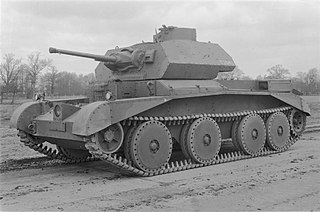
The Cruiser Tank Mk IV was a British cruiser tank of the Second World War. It followed directly on from the Tank, Cruiser, Mk III. The first Mk IVs were Mk IIIs with extra armour fitted to the turret. Later Mk IVAs were built with the complete extra armour. The tank was used in France in 1940 and in the early part of the war in North Africa, before being withdrawn from service. A fast vehicle compared to other British tanks of the early part of the war, it was probably the best tank Britain had in 1940. In total, 955 of these tanks were built.

The Ordnance QF 2-pounder, or simply "2 pounder gun", was a 40 mm (1.575 in) British anti-tank gun and vehicle-mounted gun employed in the Second World War.

The Light Tank Mark I to Mark V were a series of related designs of light tank produced by Vickers for the British Army during the interwar period.

The Carden Loyd tankettes were a series of British tankettes of the period between the World Wars, the most successful of which was the Mark VI, the only version built in significant numbers. It became a classic tankette design worldwide, was licence-built by several countries and became the basis of several designs produced in various countries.

The Vickers Medium Mark II was a British tank built by Vickers in the Inter-war period.

The Lanchester 6x4 armoured car was a British armoured car with a 6x4 drivetrain produced in limited numbers in the late 1920s and early 1930s. A heavier, more rugged development of the earlier Lanchester 4x2 armoured car, it remained in service with Territorial and colonial units until the early 1940s and saw action in the Battle of Malaya.

The Guy Armoured Car was a British armoured car produced in limited numbers during Second World War. The car saw limited action during the Battle of France.
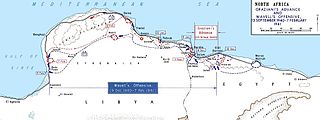
The rapid British advance during Operation Compass forced the Italian 10th Army to evacuate Cyrenaica, the eastern province of Libya. In late January, the British learned that the Italians were retreating along the Litoranea Balbo from Benghazi. The 7th Armoured Division was dispatched to intercept the remnants of the 10th Army by moving through the desert, south of the Jebel Akhdar via Msus and Antelat as the 6th Australian Division pursued the Italians along the coast road, north of the jebel. The terrain was hard going for the British tanks and Combeforce, a flying column of wheeled vehicles, was sent ahead across the chord of the jebel.

The action at Mechili was an engagement between units of the British 7th Armoured Division of the Western Desert Force and Italian forces of the 10th Army during Operation Compass.

This article on military tanks deals with the history and development of tanks of the British Army from their first use in the First World War, the interwar period, during the Second World War, the Cold War and modern era.
